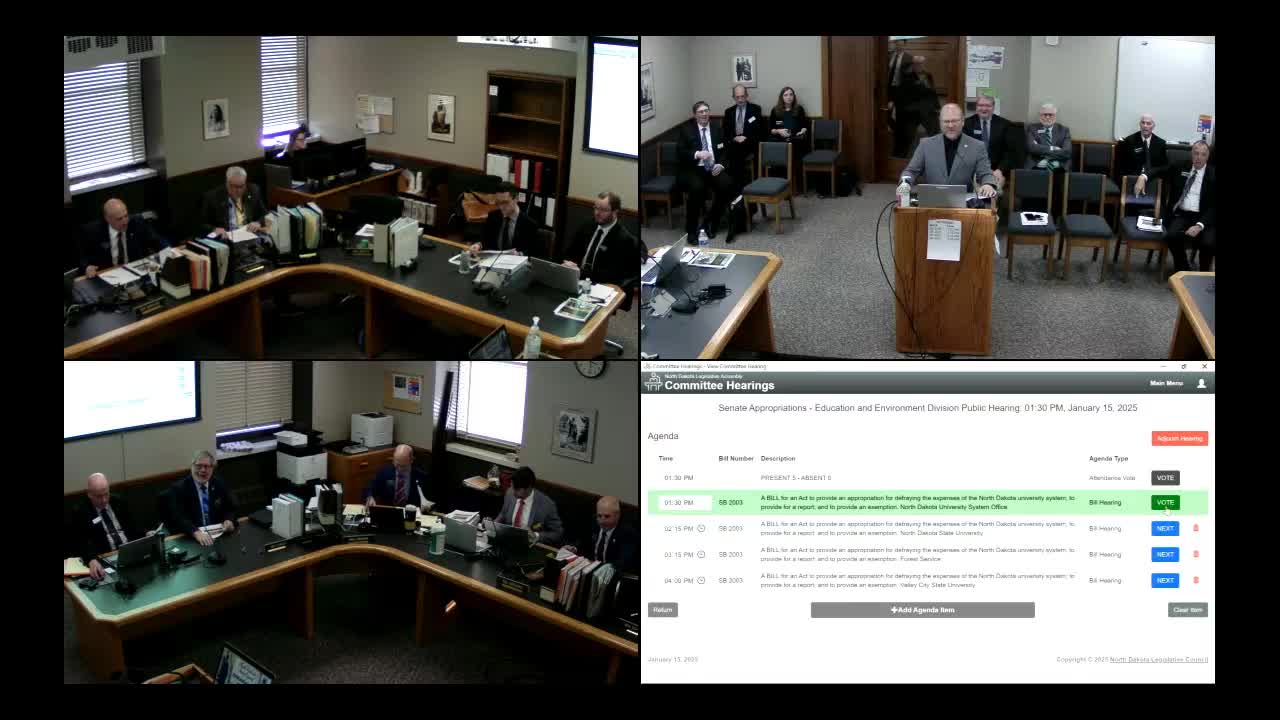Forest Service warns emerald ash borer found, requests mitigation and nursery support
January 15, 2025 | Appropriations - Education and Environment Division, Senate, Legislative, North Dakota
This article was created by AI summarizing key points discussed. AI makes mistakes, so for full details and context, please refer to the video of the full meeting. Please report any errors so we can fix them. Report an error »

Tom Claeys, state forester and head of the North Dakota Forest Service, told the Appropriations - Education and Environment Division that the agency—administratively aligned with NDSU—found emerald ash borer (EAB) in the state in 2024 and anticipates “devastating impacts.”
Why it matters: EAB attacks ash trees and could change windbreaks, shelterbelts and community tree canopy across large parts of North Dakota; mitigation will impose costs on local governments and landowners and require state coordination and funding.
Claeys described the Forest Service’s statutory duties, its organizational teams (administration; forestry and fire management; nursery and state forests) and work with local volunteer fire departments. He said the agency operates Towner State Nursery, which produces the majority of conservation conifers used across the state and has operated since 1951.
On emerald ash borer, Claeys said the insect was first confirmed in North Dakota in 2024 (the agency found it south of Jamestown at a rest area on Highway 281) and that many communities have a high percentage of ash in their public tree inventories. “Emerald ash borer is ash is the most predominant species in North Dakota ... devastating impacts we expect,” Claeys said. He told the committee the Forest Service anticipates a multi‑year response need and that available state and local funds will be insufficient without additional appropriations.
Claeys outlined two optional requests: (1) two conservation‑tree improvement FTE to support Towner State Nursery operations and succession planning ($350,000 biennial request) and (2) a one‑time emerald ash borer mitigation pool ($950,000) to help communities with removal, replanting and other responses. He described nursery workforce pressures—Towner hires seasonal workers for a 26‑week season and is struggling to attract seasonal staff—and said the nursery’s seedling price is currently about $1.05 on average.
Claeys also reviewed fire management roles: while the Forest Service does not have initial attack responsibility in North Dakota, it provides training, grants and large‑incident support; it also participates in interstate mutual‑aid compacts and can deploy resources to other states, which generates special‑fund revenue that the agency reuses for equipment and training.
Ending: Claeys asked the committee to consider the scaled optional requests and emphasized that EAB mitigation and nursery workforce support are time‑sensitive; he said the agency will provide additional materials on EAB response planning and nursery succession if the committee requests them.
Why it matters: EAB attacks ash trees and could change windbreaks, shelterbelts and community tree canopy across large parts of North Dakota; mitigation will impose costs on local governments and landowners and require state coordination and funding.
Claeys described the Forest Service’s statutory duties, its organizational teams (administration; forestry and fire management; nursery and state forests) and work with local volunteer fire departments. He said the agency operates Towner State Nursery, which produces the majority of conservation conifers used across the state and has operated since 1951.
On emerald ash borer, Claeys said the insect was first confirmed in North Dakota in 2024 (the agency found it south of Jamestown at a rest area on Highway 281) and that many communities have a high percentage of ash in their public tree inventories. “Emerald ash borer is ash is the most predominant species in North Dakota ... devastating impacts we expect,” Claeys said. He told the committee the Forest Service anticipates a multi‑year response need and that available state and local funds will be insufficient without additional appropriations.
Claeys outlined two optional requests: (1) two conservation‑tree improvement FTE to support Towner State Nursery operations and succession planning ($350,000 biennial request) and (2) a one‑time emerald ash borer mitigation pool ($950,000) to help communities with removal, replanting and other responses. He described nursery workforce pressures—Towner hires seasonal workers for a 26‑week season and is struggling to attract seasonal staff—and said the nursery’s seedling price is currently about $1.05 on average.
Claeys also reviewed fire management roles: while the Forest Service does not have initial attack responsibility in North Dakota, it provides training, grants and large‑incident support; it also participates in interstate mutual‑aid compacts and can deploy resources to other states, which generates special‑fund revenue that the agency reuses for equipment and training.
Ending: Claeys asked the committee to consider the scaled optional requests and emphasized that EAB mitigation and nursery workforce support are time‑sensitive; he said the agency will provide additional materials on EAB response planning and nursery succession if the committee requests them.
View full meeting
This article is based on a recent meeting—watch the full video and explore the complete transcript for deeper insights into the discussion.
View full meeting
